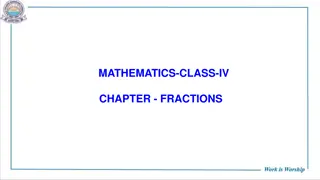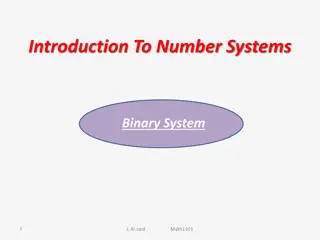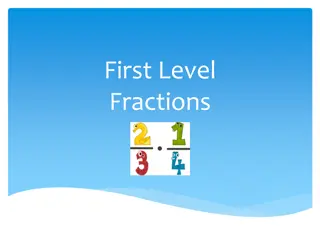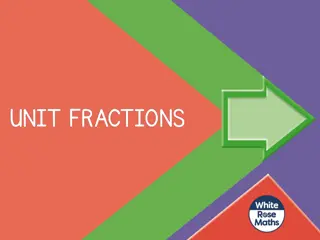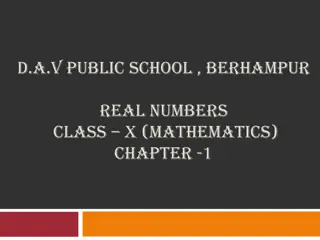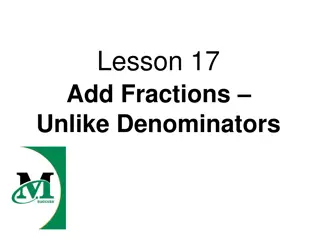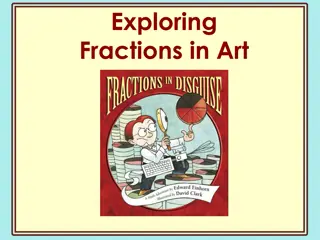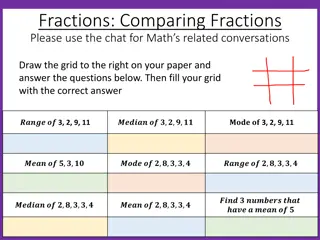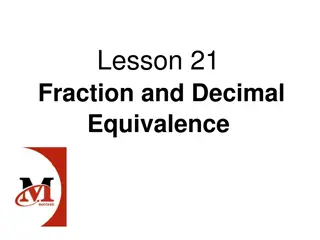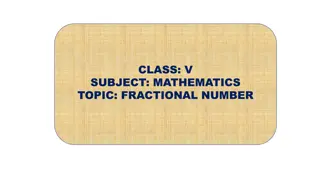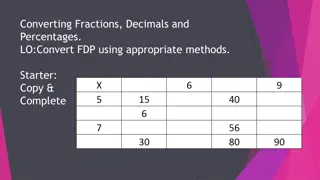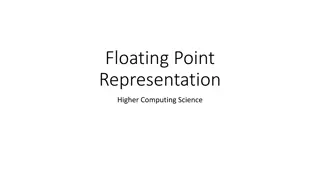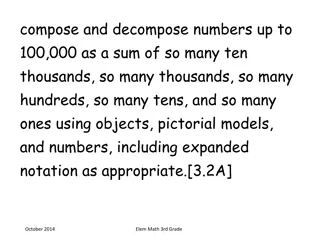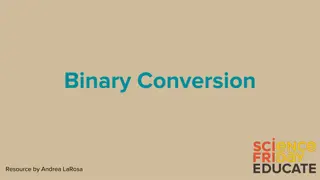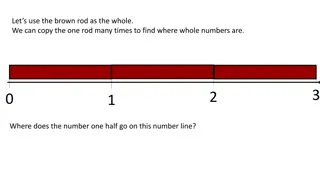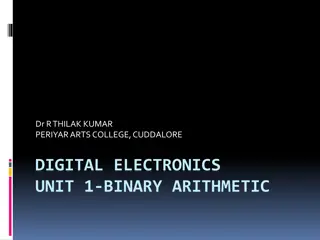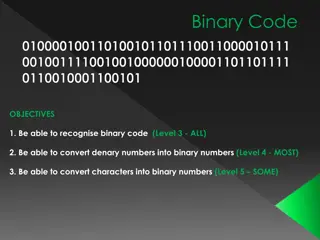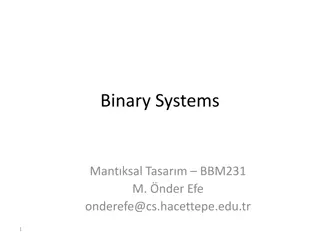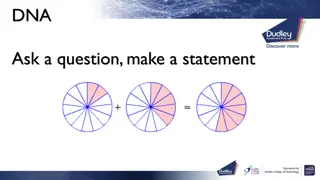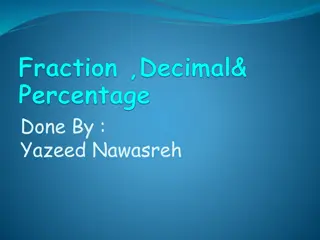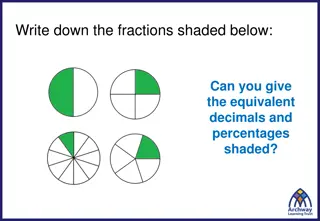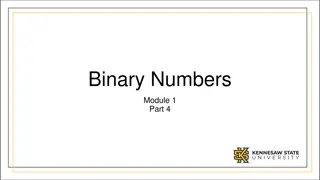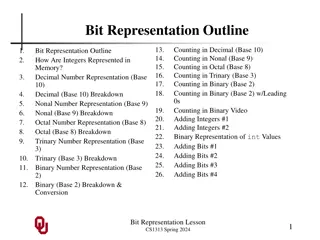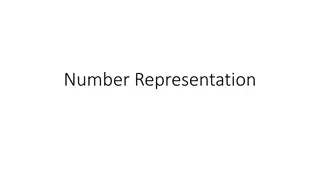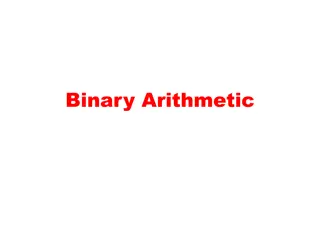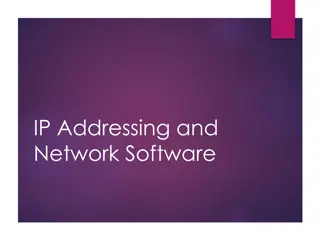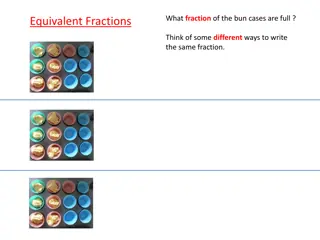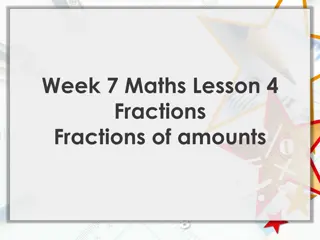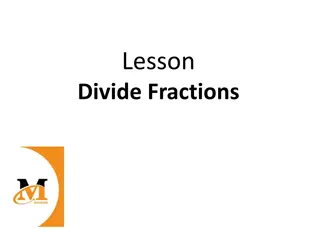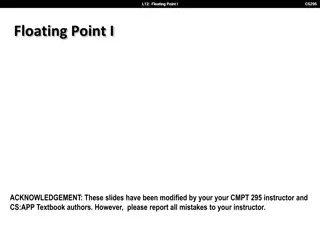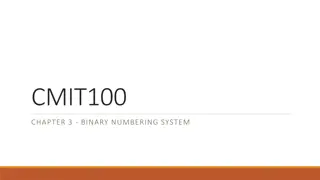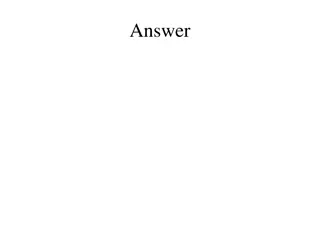Understanding Binary Representation of Numbers with Fractions
Learn how to represent numbers with fractions in binary form. Discover the process of converting real numbers, like 5.75, into binary by separating the integer and fraction parts. Explore the method of obtaining the binary representation of the fraction through division by specific decimal values. Understand the concept of floating-point numbers in binary and the trade-off between precision and range in binary scientific notation.
Download Presentation

Please find below an Image/Link to download the presentation.
The content on the website is provided AS IS for your information and personal use only. It may not be sold, licensed, or shared on other websites without obtaining consent from the author. Download presentation by click this link. If you encounter any issues during the download, it is possible that the publisher has removed the file from their server.
E N D
Presentation Transcript
Numbers with Fractions So, done with negative numbers. Done with signed and unsigned integers. How about numbers with fractions? How to represent, say, 5.75ten in binary forms?
Numbers with Fractions In general, to represent a real number in binary, you first find the binary representation of the integer part, then find the binary representation of the fraction part, then put a dot in between.
Numbers with fractions The integer part is 5tenwhich is 101two. How did you get it?
Numbers with Fractions The fraction is 0.75. Note that it is 2-1+ 2-2 = 0.5 + 0.25, so 5.75ten =101.11two
How to get the fraction In general, what you do is kind of the reverse of getting the binary representation for the integer: divide the fraction first by 0.5 (2-1), take the quotient as the first bit of the binary fraction, then divide the remainder by 0.25 (2-2), take the quotient as the second bit of the binary fraction, then divide the remainder by 0.125 (2-3),
How to get the fraction Take 0.1 as an example. 0.1/0.5=0*0.5+0.1 > bit 1 is 0. 0.1/0.25 = 0*0.25+0.1 > bit 2 is 0. 0.1/0.125 = 0*0.125+0.1 > bit 3 is 0. 0.1/0.0625 = 1*0.0625+0.0375 > bit 4 is 1. 0.0375/0.03125 = 1*0.03125+0.00625 > bit 5 is 1. And so on, until the you have used all the bits that hardware permits
Floating Point Numbers Recall scientific notation for decimal numbers A number is represented by a significand (or mantissa) and an integer exponent F * 10E Where F is the significand, and E the exponent Example: 3.1415926 * 102 Normalized if F is a single digit number 10/7/2024 CDA3100 8
Floating Points in Binary Normalized binary scientific notation xxxxxxxxxx . 1 yyyy 2 two For a fixed number of bits, we need to decide How many bits for the significand (or fraction) How many bits for the exponent There is a trade-off between precision and range More bits for significand increases precision while more bits for exponent increases the range 10/7/2024 CDA3100 9
IEEE 754 Floating Point Standard Single precision Represented by 32 bits Since the leading 1 bit in the significand in normalized binary numbers is always 1, it is not represented explicitly 10/7/2024 CDA3100 10
Exponent If we represent exponents using two s complement, then it would not be intuitive as small numbers appear to be larger 31 30 29 28 27 26 25 24 23 22 21 20 19 18 17 16 15 14 13 12 11 10 9 8 7 6 5 4 3 2 1 0 0 1 1 1 1 1 1 1 1 0 0 0 0 0 0 0 0 0 0 0 0 0 0 0 0 0 0 0 0 0 0 0 31 30 29 28 27 26 25 24 23 22 21 20 19 18 17 16 15 14 13 12 11 10 9 8 7 6 5 4 3 2 1 0 0 0 0 0 0 0 0 0 1 0 0 0 0 0 0 0 0 0 0 0 0 0 0 0 0 0 0 0 0 0 0 0 10/7/2024 CDA3100 11
Biased Notation The most negative exponent will be represented as 00 00 and the most positive as 111 11 That is, we need to subtract the bias from the corresponding unassigned value The value of an IEEE 754 single precision is 31 30 29 28 27 26 25 24 23 22 21 20 19 18 17 16 15 14 13 12 11 10 9 8 7 6 5 4 3 2 1 0 s exponent fraction 1 bit 8 bits 23 bits 127 ) 1 1 ( + (2 Exponent ) S ( . 0 Fraction ) 10/7/2024 CDA3100 12
Example 101.11two= 22 + 20 + 2-1 + 2-2 = 5.75ten The normalized binary number will be 1.0111 22 = 1.0111 2(129-127) So the exponent is 129ten = 10000001 31 30 29 28 27 26 25 24 23 22 21 20 19 18 17 16 15 14 13 12 11 10 9 8 7 6 5 4 3 2 1 0 0 1 0 0 0 0 0 0 1 0 1 1 1 0 0 0 0 0 0 0 0 0 0 0 0 0 0 0 0 0 0 0 As a hexadecimal number, the representation is 0x40B80000 10/7/2024 CDA3100 13
IEEE 754 Double Precision It uses 64 bits (two 32-bit words) 1 bit for the sign 11 bits for the exponent 52 bits for the fraction 1023 as the bias 31 30 29 28 27 26 25 24 23 22 21 20 19 18 17 16 15 14 13 12 11 10 9 8 7 6 5 4 3 2 1 0 s Exponent fraction 1 bit 11 bits 20 bits Fraction (continued) 32 bits 10/7/2024 CDA3100 14
Example (Double Precision) 101.11two= 22 + 20 + 2-1 + 2-2 = 5.75 The normalized binary number will be 1.0111 22 = 1.0111 2(1025-1023) So the exponent is 1025ten = 10000000001two 31 30 29 28 27 26 25 24 23 22 21 20 19 18 17 16 15 14 13 12 11 10 9 8 7 6 5 4 3 2 1 0 0 1 0 0 0 0 0 0 0 0 0 1 0 1 1 1 0 0 0 0 0 0 0 0 0 0 0 0 0 0 0 0 31 30 29 28 27 26 25 24 23 22 21 20 19 18 17 16 15 14 13 12 11 10 9 8 7 6 5 4 3 2 1 0 0 0 0 0 0 0 0 0 0 0 0 0 0 0 0 0 0 0 0 0 0 0 0 0 0 0 0 0 0 0 0 0 As a hexadecimal number, the representation is 0x4017 0000 0000 0000 10/7/2024 CDA3100 15
Special Cases Single precision Double precision Object represented Exponent Fraction Exponent Fraction 0 0 0 0 0 denormalized number 0 nonzero 0 nonzero floating-point number 1-254 anything 1-2046 anything infinity 255 0 2047 0 255 nonzero 2047 nonzero NaN (Not a number) 10/7/2024 CDA3100 16
Floating Point Numbers How many different numbers can the single precision format represent? What is the largest number it can represent?
Ranges for IEEE 754 Single Precision Largest positive number 31 30 29 28 27 26 25 24 23 22 21 20 19 18 17 16 15 14 13 12 11 10 9 8 7 6 5 4 3 2 1 0 0 1 1 1 1 1 1 1 0 1 1 1 1 1 1 1 1 1 1 1 1 1 1 1 1 1 1 1 1 1 1 1 Smallest positive number (floating point) 31 30 29 28 27 26 25 24 23 22 21 20 19 18 17 16 15 14 13 12 11 10 9 8 7 6 5 4 3 2 1 0 0 0 0 0 0 0 0 0 1 0 0 0 0 0 0 0 0 0 0 0 0 0 0 0 0 0 0 0 0 0 0 0 10/7/2024 CDA3100 18
Ranges for IEEE 754 Single Precision Largest positive number 254 ( 23 2 ) 2 1 1 ( + 127 = = ) 128 104 2 2 3402823466 3852885981 1704183484 516925440 38 3.4028235 10 Smallest positive number (floating point) 127 126 ) 0 . 0 + = 175494351 . 1 1 ( ) 38 1 ( 2 2 10 10/7/2024 CDA3100 19
Ranges for IEEE 754 Double Precision Largest positive number 1023 + = 7976931348 . 1 52 ( 2046 ) 1024 2 971 308 1 ( 1 2 ) 2 2 623157 10 Smallest positive number (Floating-point number) 1023 1022 308 ) 0 . 0 + = 1 ( ) 1 ( 2 2 2250738585 . 2 10 10/7/2024 CDA3100 20
Comments on Overflow and Underflow Overflow (and underflow also for floating numbers) happens when a number is outside the range of a particular representation For example, by using 8-bit two s complement representation, we can only represent a number between - 128 and 127 If a number is smaller than -128, it will cause overflow If a number is larger than 127, it will cause overflow also Note that arithmetic operations can result in overflow 10/7/2024 CDA3100 21


